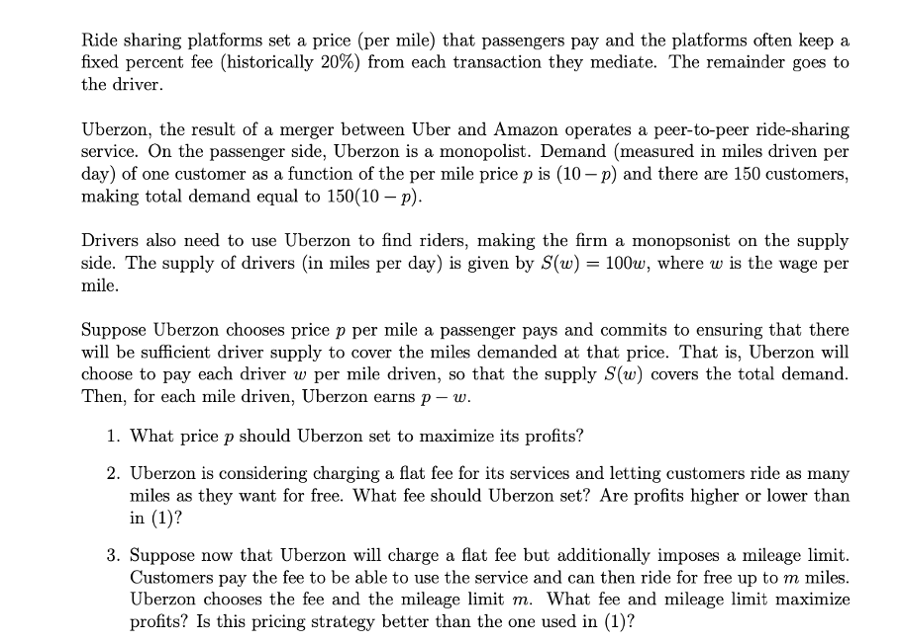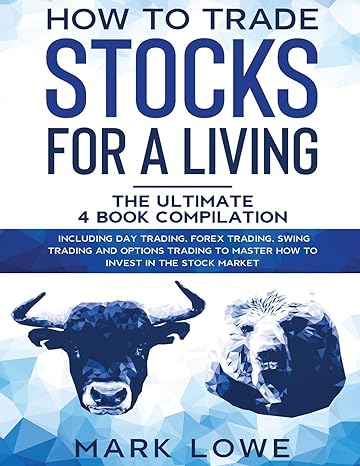***Please clearly show all the steps***

Ride sharing platforms set a price (per mile) that passengers pay and the platforms often keep a fixed percent fee (historically 20%) from each transaction they mediate. The remainder goes to the driver. Uberzon, the result of a merger between Uber and Amazon operates a peer-to-peer ride-sharing service. On the passenger side, Uberzon is a monopolist. Demand (measured in miles driven per day) of one customer as a function of the per mile price p is (10 p) and there are 150 customers, making total demand equal to 150(10 p). Drivers also need to use Uberzon to find riders, making the firm a monopsonist on the supply side. The supply of drivers (in miles per day) is given by S(w) = 100w, where w is the wage per mile. Suppose Uberzon chooses price p per mile a passenger pays and commits to ensuring that there will be sufficient driver supply to cover the miles demanded at that price. That is, Uberzon will choose to pay each driver w per mile driven, so that the supply S(w) covers the total demand. Then, for each mile driven, Uberzon earns p w. 1. What price p should Uberzon set to maximize its profits? 2. Uberzon is considering charging a flat fee for its services and letting customers ride as many miles as they want for free. What fee should Uberzon set? Are profits higher or lower than in (1)? 3. Suppose now that Uberzon will charge a flat fee but additionally imposes a mileage limit. Customers pay the fee to be able to use the service and can then ride for free up to m miles. Uberzon chooses the fee and the mileage limit m. What fee and mileage limit maximize profits? Is this pricing strategy better than the one used in (1)? Ride sharing platforms set a price (per mile) that passengers pay and the platforms often keep a fixed percent fee (historically 20%) from each transaction they mediate. The remainder goes to the driver. Uberzon, the result of a merger between Uber and Amazon operates a peer-to-peer ride-sharing service. On the passenger side, Uberzon is a monopolist. Demand (measured in miles driven per day) of one customer as a function of the per mile price p is (10 p) and there are 150 customers, making total demand equal to 150(10 p). Drivers also need to use Uberzon to find riders, making the firm a monopsonist on the supply side. The supply of drivers (in miles per day) is given by S(w) = 100w, where w is the wage per mile. Suppose Uberzon chooses price p per mile a passenger pays and commits to ensuring that there will be sufficient driver supply to cover the miles demanded at that price. That is, Uberzon will choose to pay each driver w per mile driven, so that the supply S(w) covers the total demand. Then, for each mile driven, Uberzon earns p w. 1. What price p should Uberzon set to maximize its profits? 2. Uberzon is considering charging a flat fee for its services and letting customers ride as many miles as they want for free. What fee should Uberzon set? Are profits higher or lower than in (1)? 3. Suppose now that Uberzon will charge a flat fee but additionally imposes a mileage limit. Customers pay the fee to be able to use the service and can then ride for free up to m miles. Uberzon chooses the fee and the mileage limit m. What fee and mileage limit maximize profits? Is this pricing strategy better than the one used in (1)







